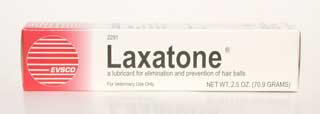 |
|
|
Introduction: Hairballs are a common occurrence in cats. Usually hairballs are more of a nuisance than a serious cause for concern. However, once in a while hairballs can create a problem in the catís digestive system that can lead to more serious problems.
Cause: When cats groom themselves, they swallow hair that they shed from their coats. This hair normally passes through the catís digestive system and is expelled in the feces. However, there are times when a mass of hair can build up and not move through the catís digestive tract. This ball of hair creates a blockage that can interfere with the catís normal digestion.
Clinical Signs: Cats with hairballs often vomit, cough, and gag. The cat may also become constipated, have a reduced appetite, or stop eating altogether.
Treatment: Normally, the cat can resolve this problem on its own by coughing or vomiting up the hairball. If the cat is unable to do so, there are some commercial products that can help the cat get rid of hairballs. These products often contain oil-like ingredients which lubricate the catís digestive tract and hopefully allow the hairball to pass through more easily. The product Laxatone, found below, and the product Laxíaire (page H462) are examples of products used to prevent and sometimes remove hairballs. In extreme cases, if the hairball is not expelled, it may have to be surgically removed by a veterinarian.
Prevention: An appropriate diet and daily brushing can help prevent the formation of hairballs. Foods high in fiber can naturally keep things moving along in the catís digestive tract. Regularly brushing the cat helps to remove some of the hair that might otherwise accumulate in the digestive tract. It is recommended to brush the cat more often when it sheds excessively (during warm weather and shedding seasons) or if the cat has long hair.
 |
|
|